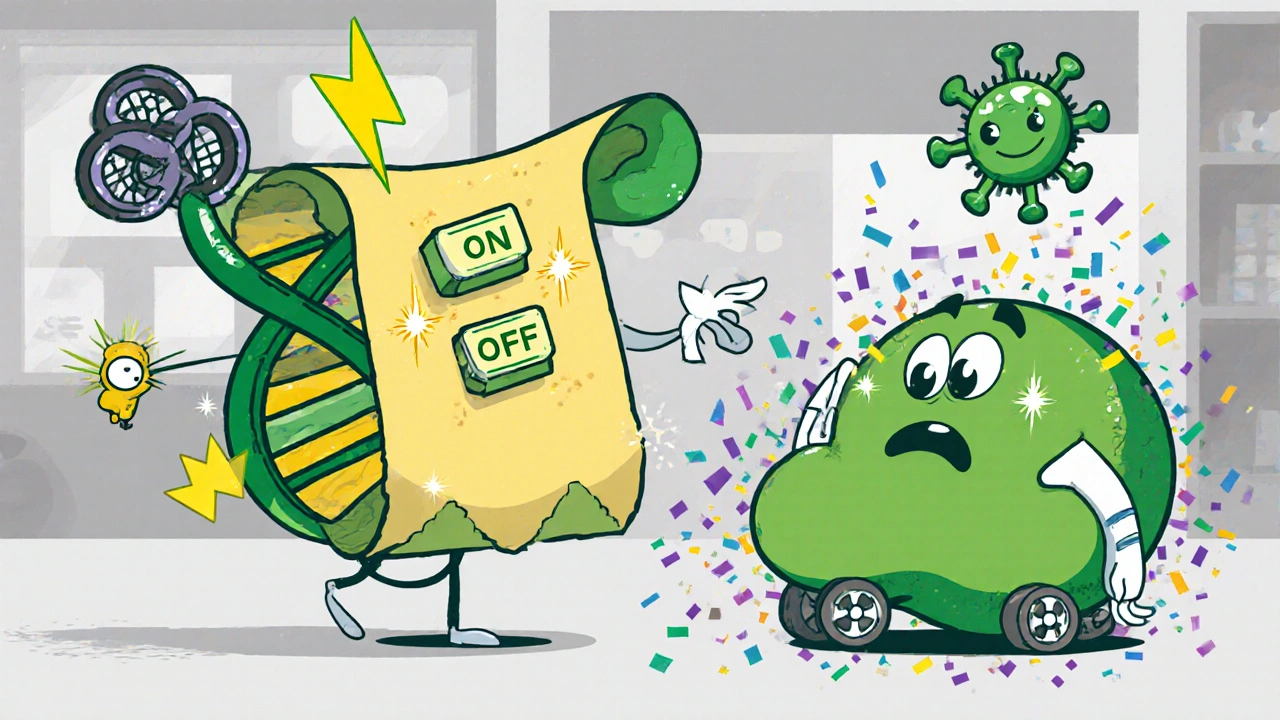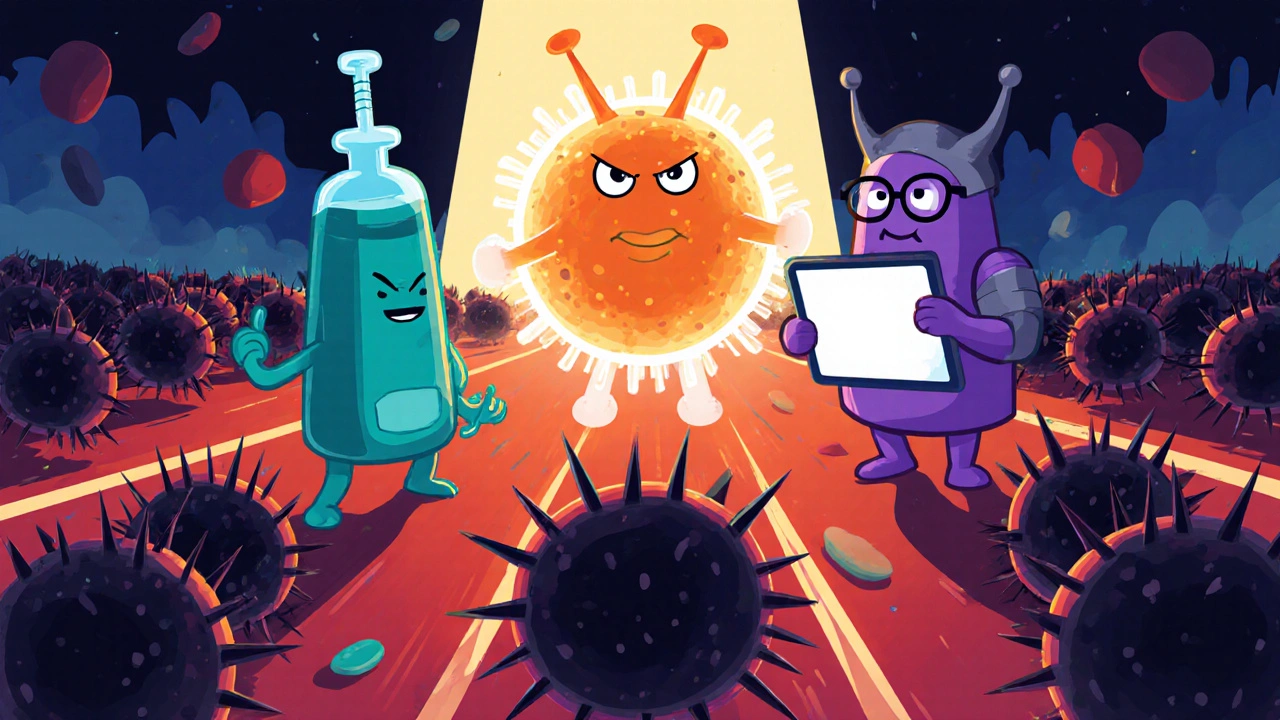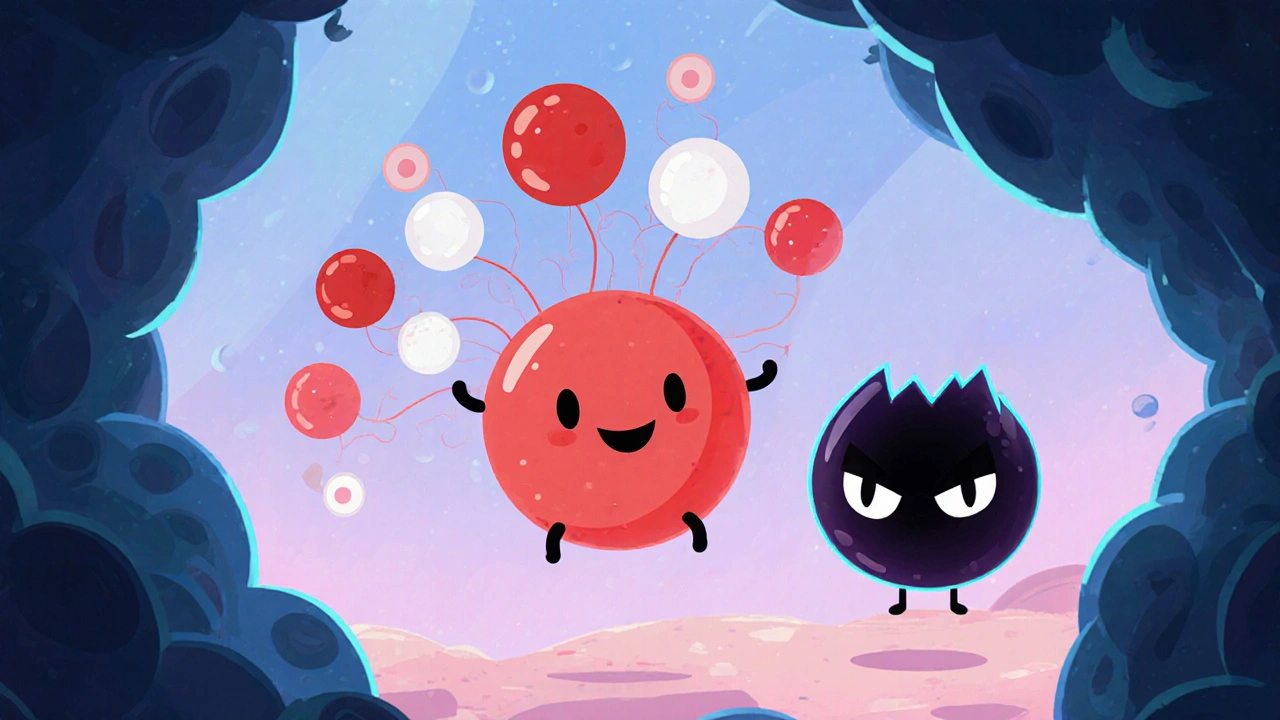Blood Cancer Risk Factor Calculator
Assess your relative risk based on genetic predisposition, environmental exposures, and lifestyle factors. Data is based on the science explained in the article.
Your Risk Factors
When you hear the term blood cancer, it often feels abstract-something that happens far away in a lab. In reality, it’s a very personal story for millions of people worldwide, and the science behind how it starts is anything but mysterious. Below we break down the biology, genetics, and environment that turn a healthy blood cell into a malignant one.
What Exactly Is Blood Cancer?
Blood cancer is a type of cancer that originates in the blood‑forming (hematopoietic) tissues such as bone marrow, or in the circulating blood cells themselves. It falls under the broader umbrella of hematologic malignancies, which includes three main groups: leukemia, lymphoma, and multiple myeloma. Each group targets a different cell lineage, but they share a common story of uncontrolled cell growth.
From Stem Cell to Blood Cell: The Process of Hematopoiesis
Hematopoiesis is the continuous production of all blood cells from multipotent stem cells in the bone marrow. Normally, a single hematopoietic stem cell divides into progenitor cells that become red blood cells, white blood cells, or platelets, each with a specific function and lifespan. The balance is tightly regulated by growth factors and signaling pathways, ensuring that the body has enough cells to carry oxygen, fight infection, and clot wounds.
Genetic Mutations: The Spark That Ignites Cancer
When the DNA inside a stem or progenitor cell acquires a mutation, the safety checks can fail. Two major types of genetic changes drive blood cancer:
- Oncogenes are genes that, when mutated or over‑expressed, promote cell proliferation and survival. A classic example is the FLT3 mutation found in acute myeloid leukemia (AML), which keeps the cell in a perpetual growth loop.
- Tumor suppressor genes are genes that normally halt cell division or trigger apoptosis; loss‑of‑function mutations remove these brakes. The TP53 gene, often called the "guardian of the genome," is frequently inactivated in aggressive blood cancers.
These mutations can be inherited, arise spontaneously during DNA replication, or be induced by external agents.
The Role of Bone Marrow and Stem Cells
Bone marrow is the spongy tissue inside our long bones where hematopoietic stem cells reside and differentiate. When a mutated stem cell takes hold, it can crowd out healthy cells, creating a niche where the malignant clone dominates. Over time, the marrow becomes fibrotic and less able to produce normal blood components, leading to symptoms like anemia, infections, and bleeding.

Environmental and Lifestyle Triggers
Beyond genetics, several external factors increase the odds of developing a blood cancer:
- Radiation exposure: High‑dose radiation (e.g., atomic bomb survivors, therapeutic radiation) damages DNA in marrow cells. \n
- Chemical agents: Benzene-a solvent used in petrochemical industries-and certain pesticides have been linked to leukemia.
- Viral infections: The Epstein‑Barr virus (EBV) is associated with some lymphomas, while human T‑cell leukemia virus (HTLV‑1) can cause adult T‑cell leukemia.
- Smoking: Introduces carcinogens that circulate to the marrow and can trigger mutations.
These risks are dose‑dependent and often combine with genetic susceptibility, creating a perfect storm for malignant transformation.
From Mutation to Disease: How Cancer Grows
Once a mutated cell gains a growth advantage, it undergoes clonal expansion-producing many identical copies. Additional “secondary” mutations may appear, giving the clone resistance to apoptosis, the ability to evade the immune system, or the capacity to infiltrate other organs. This multi‑step process explains why blood cancers can evolve from an indolent state (e.g., chronic lymphocytic leukemia) to an aggressive one (e.g., acute lymphoblastic leukemia) over months or years.
Treatment Landscape: From Traditional to Targeted
Understanding the biology of blood cancer directly informs therapy choices. Two broad categories dominate today:
- Chemotherapy is a systemic treatment that kills rapidly dividing cells, both cancerous and healthy. It remains the backbone for many acute leukemias, often combined with steroids.
- Immunotherapy includes approaches that harness the immune system, such as CAR‑T cells and checkpoint inhibitors. These have provided dramatic remission rates in certain lymphomas and multiple myeloma.
Targeted agents-like tyrosine‑kinase inhibitors for BCR‑ABL in chronic myeloid leukemia-zero in on specific mutations, reducing collateral damage. Ongoing research into epigenetic modulators, bispecific antibodies, and next‑generation CAR‑T designs promises even more precise options.

Comparing the Three Main Types of Blood Cancer
| Feature | Leukemia | Lymphoma | Multiple Myeloma |
|---|---|---|---|
| Primary cell type | Blood‑forming (myeloid or lymphoid) cells | Lymphocytes in lymph nodes or extranodal sites | Plasma cells in bone marrow |
| Common age | Children (ALL) or older adults (AML) | Young adults to elderly, varies by subtype | Typically >60 years |
| Typical symptoms | Fatigue, easy bruising, infections | Swollen lymph nodes, night sweats, weight loss | Bone pain, anemia, kidney problems |
| Standard first‑line therapy | Combination chemotherapy +/- targeted agents | Immunochemotherapy (e.g., R‑CHOP) or radiation | Proteasome inhibitor + immunomodulatory drug + steroid |
Take‑Away Checklist
- Blood cancer starts in the bone marrow or circulating blood cells.
- Mutations in oncogenes or tumor suppressor genes give cells a growth advantage.
- Environmental exposures (radiation, chemicals, viruses) can trigger DNA damage.
- Clonal expansion and secondary mutations drive disease progression.
- Treatment now mixes chemotherapy, targeted drugs, and immunotherapy tailored to the genetic profile.
Frequently Asked Questions
What is the difference between leukemia and lymphoma?
Leukemia originates in the blood‑forming cells of the bone marrow and circulates in the bloodstream, while lymphoma starts in lymphocytes that form solid tumors in lymph nodes or other tissues.
Can lifestyle changes reduce my risk of blood cancer?
Avoiding known carcinogens-like tobacco smoke, benzene exposure, and excessive radiation-can lower risk. A diet rich in antioxidants and regular exercise support overall cellular health, though genetics still play a major role.
How are blood cancers diagnosed?
Diagnosis typically involves a complete blood count, bone‑marrow biopsy, flow cytometry, and genetic testing to identify specific mutations.
Is there a cure for blood cancer?
Some blood cancers, like certain acute leukemias, can be cured with aggressive treatment. Others become chronic conditions managed long‑term with targeted therapies and regular monitoring.
What new therapies are on the horizon?
Emerging options include next‑generation CAR‑T cells, bispecific antibodies that link cancer cells to immune cells, and epigenetic drugs that reverse abnormal DNA methylation patterns.
Understanding the science behind blood cancer demystifies a disease that touches so many lives. By grasping how normal blood formation goes awry, patients, families, and clinicians can make smarter choices about prevention, early detection, and treatment.


Nikita Shue
Wow, this breakdown really nails the basics of how blood cancers start – love the clear step‑by‑step vibe! It’s crazy how a tiny DNA slip can snowball into a full‑blown disease. If you’re reading this and feeling overwhelmed, remember that knowledge is power, and staying informed can help you spot red flags early. Keep digging, stay curious, and share this with anyone who might need a quick science refresher.
Ryan Spanier
Thank you for presenting such a comprehensive overview of hematologic malignancies. The delineation between oncogenic drivers and tumor suppressor loss is particularly helpful for clinicians translating genetics into therapeutic decisions. It is also commendable that environmental risk factors are addressed alongside inherited predispositions, underscoring the multifactorial nature of disease etiology. I encourage fellow readers to consider this synthesis when discussing risk mitigation strategies with patients.
Abhinav Moudgil
Impressive synthesis! The way you illustrated the cascade from a solitary stem‑cell mutation to clonal dominance reads like a molecular thriller. I especially appreciated the vivid analogy of a “perfect storm” brewing within the marrow niche – it paints a clear picture of how genetics and exposure intertwine.
Peter Rupar
Look, all this fancy talk hides the fact that most people ignore basic safety and end up with cancer anyway. Stop blaming the environment and start taking responsibility for your own exposure. If you keep dancing around the issue, no one’s gonna change their habits.
bill bevilacqua
Well, this article does a decent job of summarizing the science, but honestly, it feels like a watered‑down version of what we already know. The US healthcare system could use this level of clarity, yet we still lag behind many other nations-especially when it comes to early detection programs! Plenty of other countries get it right, and we’d be better off borrowing their models.
rose rose
Don't be fooled. Big Pharma funded these “research summaries” to push their pricey drugs while keeping the public clueless.
Emmy Segerqvist
OMG!!! This is a total eye‑opener!!!
Grace Baxter
While I acknowledge the enthusiasm, I must point out that the narrative presented here glosses over the systemic failures that stem from our own policy choices. It’s not enough to marvel at the molecular intricacies without addressing how our healthcare infrastructure systematically underfunds bone‑marrow research, especially compared to nations that prioritize scientific advancement. Moreover, the emphasis on targeted therapies often serves as a smokescreen for the pharmaceutical lobby’s profit motives, diverting resources from preventative measures that could reduce incidence rates. In short, celebrating scientific breakthroughs without a concurrent critique of the socio‑political context feels premature and, frankly, disingenuous.
Eddie Mark
Man, reading this feels like taking a roller‑coaster ride through the hidden world inside our veins. First off, the bone‑marrow is basically a bustling city where stem cells work the night shift, churning out red blood cells, white warriors, and those little platelet traffic cops. When a random typo in the DNA code pops up-boom-suddenly you’ve got a rogue cell that thinks it’s the mayor of the whole operation. That rogue starts to throw its weight around, crowding out the good‑natured citizens and turning the whole town into a wasteland. The article nails the whole oncogene‑versus‑tumor‑suppressor tug‑of‑war, and it’s wild how a single FLT3 tweak can make a cell act like it’s on steroids. Then there’s TP53, the old watchdog that, when knocked out, leaves the doors wide open for chaos. Add a dash of radiation, a splash of benzene, or a viral hitchhiker, and you’ve got a perfect storm brewing-think of it like a bad mixtape of bad habits. What’s cool is that modern therapy is finally catching up, with chemo’s old‑school punch and CAR‑T’s sci‑fi laser beams both joining the fight. I love how the piece breaks down the difference between leukemia, lymphoma, and myeloma without turning it into a boring textbook lecture. The tables and checklists are like cheat‑codes for anyone trying to navigate this maze. And hey, the FAQ at the end is a solid move-answers to the “what’s the diff?” and “can I prevent it?” that most of us are itching to know. Bottom line: knowledge is the best armor, and this article hands out the shields pretty nicely. So if you’re scrolling through Reddit and feel like the science is a murky swamp, dive into this read and come out with a clearer map. Keep spreading the word, because the more people who get the gist, the stronger our collective defense becomes.